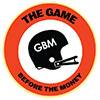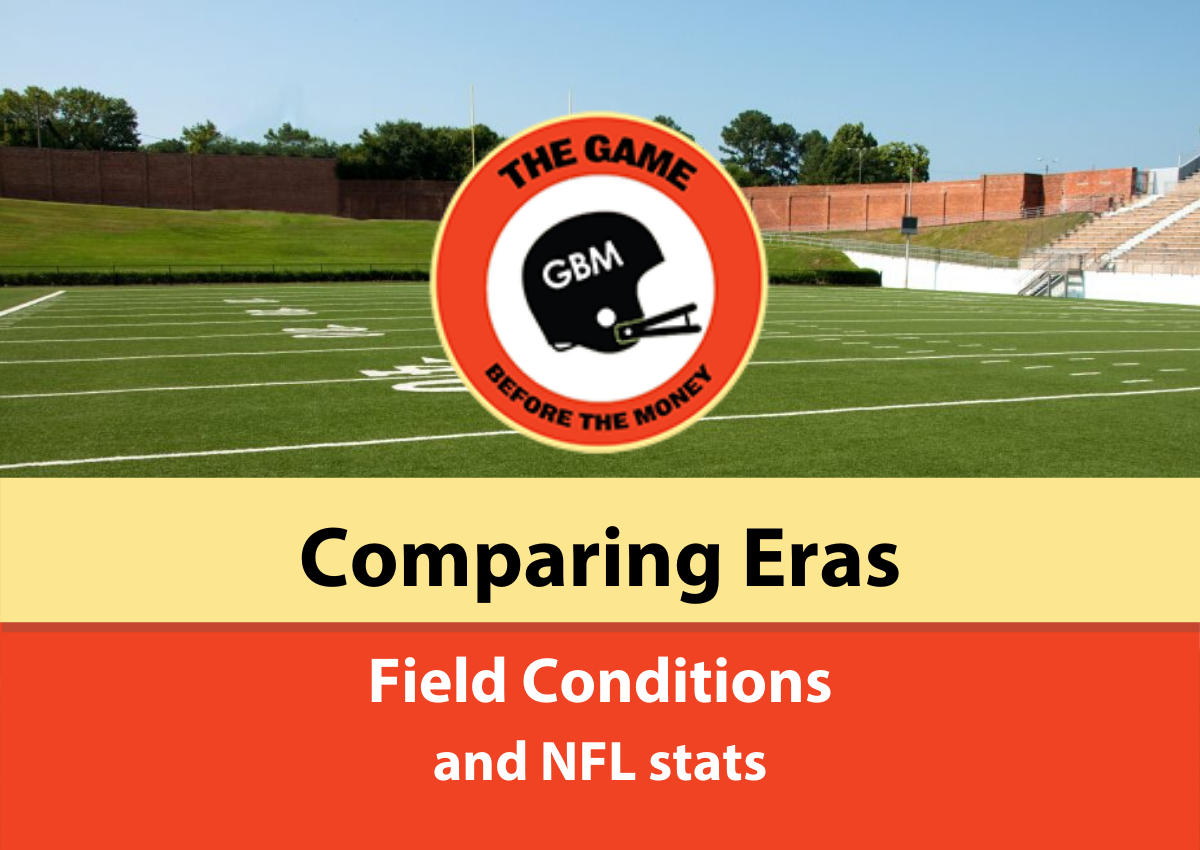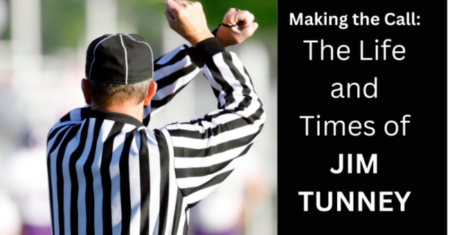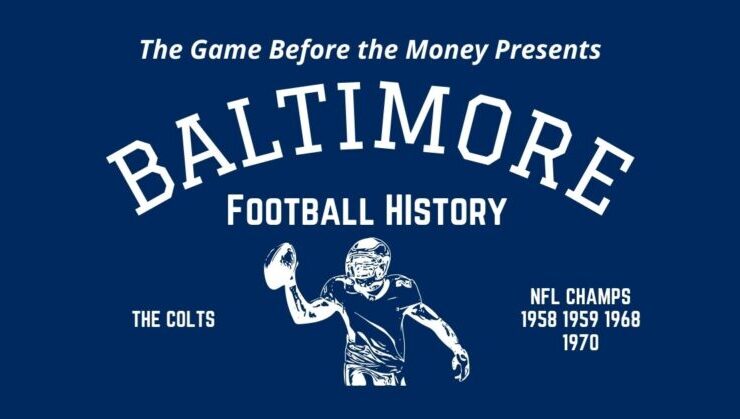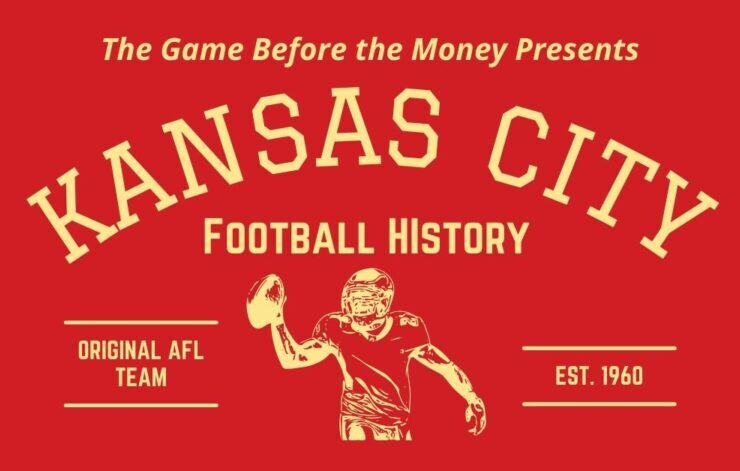Is it possible to compare eras in NFL history? What factors do you need to consider when comparing eras of football history? This series of posts outlines some of the factors that make things difficult in comparing eras.
COMPARING STATS OF DIFFERENT NFL ERAS
When you look at football stats you might think, “1,000 yards is 1,000 yards, right?” Well, in terms of measurement, yes. At least two field factors need to be considered when comparing Leroy Kelly to Earl Campbell to Emmitt Smith to Christian McCaffrey. The first factor we’ll look at is field conditions. The second factor we’ll address is that field measurements have actually changed in at least one major way.
HOW NFL PLAYING FIELDS HAVE CHANGED
Recent pro and college playing surfaces that stage the athletic feats of Derrick Henry and Saquon Barkley differ greatly from those that spotlighted the work of people like Franco Harris and even receivers like Jerry Rice and Cliff Branch. Below is a slideshow of two photos: Harris and Henry. Note the difference in playing surfaces.
Embed from Getty ImagesToday’s NFL enforces strict playing field standards that require the field be level and “in the best possible condition to showcase the players’ skills.” The league tests all fields within 72 hours of the game with special equipment.
That wasn’t the case in previous eras – far from it. Anybody remember the Mud Bowl between the Rams and Vikings in the 1977 NFL playoffs? What about the 1965 NFL Championship Game?
Below are photos of Jim Taylor and Paul Hornung from the 1965 NFL Championship Game. Taylor gained 96 yards rushing that day and Hornung 105 – on a muddy Lambeau Field. The great Jim Brown had nearly 100 yards from scrimmage (photos of him on that day are at the end of this article).
Embed from Getty ImagesYes, San Francisco and Washington played on a wet field in 2019 and the Steelers and Dolphins played on Monday Night Football in 2007 on a sloppy field – and there was a combined total of 12 points scored in those games. Those fields stayed relatively intact versus the baseball playing fields so often played on before recent times. Below is an example of a Vikings vs Falcons regular season game in the late 1970s. Such scenes were not uncommon during that era.
Embed from Getty Images.How many more yards would Chuck Foreman have gained on more consistent playing fields? How many more receiving yards would Bob Hayes have gained on a perfect playing surface? How many fewer yards would today’s players have? It’s tough to answer, especially when you consider the defensive players share the same perfect field conditions of today to get to a spot faster than their early counterparts. Certainly great runners can run at full speed all game, every game, without having to trudge through inches of mud.
Today’s fields are built to maximize athletic performance and use high levels of technology to ensure the best possible field conditions. This stands quite notable in comparing artificial surfaces of today against those of the 1960s and 1970s. Houston Oilers Ken Houston and Garland Boyette described the Astrodome’s field in We Were the Oilers: The Luv Ya Blue Era documentary that also delved into the team’s formation. Boyette noted conduit running underneath the field and a turf that was so sharp that he still has scars. Houston surmised that the Houston Oilers might have invented the stand-up tackle to avoid scraping the turf. Players have also noted problems with turf at other stadiums.
Today’s artificial surfaces are designed with athleticism in mind and are far less abrasive. NFL fields of dreams in days of yore weren’t the finely tuned fields of today. That’s not saying that current players wouldn’t have excelled on those fields but field conditions are something to think about when comparing eras and statistics.
Looking for a great NFL history book? Check out The Game Before the Money: Voices of the Men Who Built the NFL available at — Amazon.com – Barnes and Noble – University of Nebraska Press
HOW NFL FIELD MARKINGS HAVE CHANGED
As stated in the well-read A Brief History of Hash Marks, placement of hash marks affect NFL statistics. The NFL moved the hash marks considerably closer together in the early 1970s. The move unleashed offenses and helped running backs, receivers, quarterbacks, and even kickers.
Gale Sayers noted that he gained over 1,000 yards in 1966 and only a handful of running backs accomplished that feat before him. He pointed out that 10 running backs gained 1,000 yards in the 1972 season after the hash marks closed in.
A look at the record book proves Sayers’ statement correct. Ten running backs reach the 1,000 yard-plateau in 1972. The 1972 Dolphins had two players achieve that feat – Larry Csonka and Mercury Morris. Compare that to 1970 when only two players in the entire NFL reached 1,000 yards – Larry Brown and Ron Johnson. In 1969, Gale Sayers was the only running back to gain 1,000 yards in the NFL. Think the supercharged offenses of the AFL ran better? Only one player in the AFL topped 800 yards in 1969 – Dickie Post.
There are many factors to consider when comparing NFL eras. Although it is possible it is difficult to do with precision. We will discuss all of this more in future posts and on The Game before the Money Podcast. The point is not to say that today’s players couldn’t play on the fields of the past and not put up great stats. It’s not to say that players in the 2020s are better or worse than players of the 1950s. The objective is to point out that there are many hidden factors to comparing players in different eras.
Hear NFL and college football legends share their stories! Subscribe to The Game before the Money Podcast on your favorite listening platform, including on Apple Podcasts, iHeartRadio, Spotify, Stitcher, and Google Play.
Here is JIm Brown and others during the 1965 NFL Championship Game. How do you think today’s players would fare under those field conditions?
Embed from Getty Images